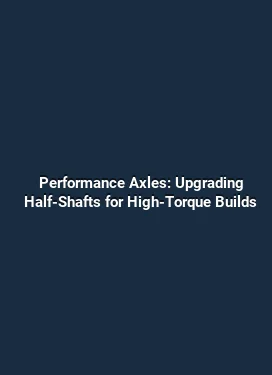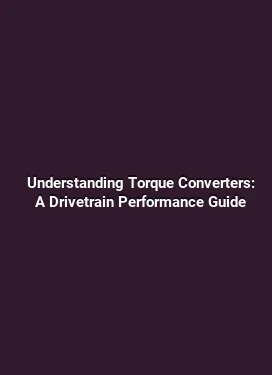Twin Disc Clutch vs Single Disc: Drivability and Performance
Clutch technology sits at the intersection of engagement precision, torque handling, and overall vehicle feel. Within the realm of manual transmissions and performance-oriented builds, choosing between twin disc and single disc configurations can influence not only peak power handling but also daily drivability. This article explores the core differences, practical implications, and decision-making criteria for enthusiasts and professionals aiming to optimize their drivetrain behavior without compromising reliability.
Overview of Clutch Configurations

Clutches transmit engine torque to the transmission through friction, with the goal of smooth engagement, predictable pedal response, and resistance to heat buildup during high-load events. A single disc clutch employs one friction disc backed by pressure plate and a flywheel. In contrast, a twin disc clutch uses two friction discs separated by a torsion spring damper assembly, typically with a pressure plate driving both discs in unison. The dual-disc arrangement increases the overall surface area and friction material exposed to the clutch face, enabling higher torque transmission before slip and improved heat management under sustained loads.
From a mechanical standpoint, a twin disc assembly distributes engagement forces across two contact surfaces, reducing localized wear on any single surface. This architecture can yield a broader clutch engagement window and a more linear transition from slip to full engagement. For applications involving abrupt power delivery—such as high-spirited launches or track use—the twin-disc setup often maintains stable bite characteristics under repeated heat cycling, which is a common driver of fade in high-performance single disc configurations.
Drivability Factors Affected by Clutch Design
Drivability is a composite of pedal feel, engagement smoothness, and the predictability of torque transfer during shifting and daily operation. Clutch design plays a pivotal role in shaping these attributes, particularly when comparing twin disc and single disc configurations. For street-driven cars with moderate power, a single disc clutch typically provides crisp yet manageable engagement and a light-to-moderate pedal effort. However, as power and torque demands rise, the benefits of a twin disc setup become more pronounced in terms of stability and repeatability across a wider temperature range.
Pedal effort, engagement point, and fade resistance are frequently cited as decision drivers in clutch selection. A well- engineered twin disc system can maintain engagement precision even as friction materials heat up, reducing the chance of vicious engagement spikes or abrupt disengagement during hot-lapping sessions. Conversely, a single disc clutch may exhibit greater sensitivity to heat soak, particularly if the vehicle operates at or near its peak torque capacity for extended periods. This is not a universal rule, but a trend observed in tuned street cars and race-inspired builds where sustained power delivery is common.
Engagement Feel and Pedal Effort

Engagement feel refers to how smoothly the clutch engages as the pedal is released. Twin disc assemblies, due to their distributed contact surfaces and damped engagement, often deliver a more forgiving ramp. The pedal effort required can vary with the pressure plate design and the overall weight of the assembly, but many practitioners report that twin discs maintain a consistent engagement window even after repeated heat cycling. For drivers who prioritize a gentle yet confident engagement—such as daily commuters with spirited driving tendencies—a twin disc option can reduce the chance of sudden engagement surges that disrupt forward motion at low speeds.
In contrast, a high-performance single disc can offer an ultra-precise engagement point with very direct feedback. The trade-off may be a steeper engagement ramp or a slightly stiffer pedal in some configurations, especially if the system is tuned for aggressive launches. This is often desirable for drivers who favor a race-inspired interface and are willing to accommodate a firmer pedal feel for the sake of quicker, more actionable shifts under load.
Vibration, Smootness, and Heat Management
Vibration characteristics and smoothness are linked to the damper and hub assembly within the pressure plate. Twin disc setups typically implement a multi-disc dampening strategy that helps absorb micro-oscillations and transient torque spikes. This translates to a smoother engagement under aggressive throttle inputs and during abrupt shifts. Additionally, the doubled surface area facilitates better heat distribution across friction material, which can reduce localized hot spots that degrade smoothness during repeated use.
Heat management is a critical factor in high-performance drivetrains. Twin discs spread the friction load and can maintain lower average temperatures during sustained hard driving. While a single disc can handle excellent heat dissipation when paired with high-quality materials and efficient cooling, the twin-disc arrangement inherently provides a higher thermal reserve, which translates to less risk of fade during long sessions or hot days on the track.
Performance Implications for Transmission & Drivetrain
Performance outcomes are not solely about raw torque capacity; they also hinge on how consistently the clutch engages, how quickly power can be transmitted through the drivetrain, and how effectively heat is managed. Twin disc and single disc clutches each impart distinct signatures on the transmission and overall drivetrain performance, influencing shift quality, response, and durability in demanding scenarios.
Torque handling is a primary differentiator. While both configurations can be engineered to meet specific power levels, twin discs generally provide higher peak torque capabilities due to the combined friction surface area and improved heat capacity. This can be advantageous for applications featuring high-time-averaged torque or frequent high-load events, such as competitive racing or spirited track days. For vehicles with modest power goals, a high-quality single disc can deliver ample torque capacity with a more compact package and potentially lighter overall weight.
Shift feel and response are also affected by clutch surface interaction. Twin disc assemblies can reduce mid-cycle slippage during rapid gear changes, aiding in maintaining drive torque through the shift sequence. The result is crisper, more repeatable shifts, especially under high-load conditions. In contrast, single disc clutches may exhibit slightly more pedal travel to reach full engagement, but when tuned correctly, can offer an exceptionally direct and immediate connection that suits drivers aiming for immediate throttle response in corner-exit scenarios.
Torque Handling and Heat Dissipation
The core objective of any performance clutch is to maximize usable torque while minimizing heat-related degradation. Twin discs leverage dual friction surfaces to spread heat generation, which reduces the likelihood of hot spots and clutch fade during long stints of aggressive driving. This becomes particularly evident in endurance events or prolonged street sessions where sustained torque demands are common. The ability to maintain consistent engagement and pressure across cycles helps preserve drivability and reduces the risk of torque interrupting during gear transitions.
Heat dissipation also requires attention to the overall cooling strategy of the powertrain.drivetrain designers often integrate intercooling, improved venting, and optimized airflow through the bell housing to complement clutch performance. While a single disc setup can be engineered for excellent thermal behavior, the twin disc configuration offers a higher margin of safety when heat soak is a primary concern, especially in high-power builds or vehicles with aggressive gearing that keeps engine rpm in a torque-rich band for extended periods.
Spring Dampening and Engagement Stability
Torsion springs and damper assemblies within the clutch system influence engagement stability. Twin disc clutches frequently employ a damped hub approach that mitigates torsional shock transmitted through the drivetrain during clutch engagement and disengagement. This translates to smoother torque transfer for the transmission input shaft and can reduce wear on the release bearing and pilot bearing over time. For vehicles used in mixed driving conditions where engagement occurs frequently at varying rpm, dampened engagement helps maintain a steady drive profile without abrupt jolts.
Single disc configurations can be tuned for minimal inertia and crisp engagement, often appealing to racers who value a direct, predictable feel. However, this can also yield more pronounced engagement behavior on the street, particularly if the pedal geometry amplifies the initial bite. The choice depends on balancing the desired engagement character with the practical realities of daily driving, track duty cycles, and maintenance considerations.
Choosing Between Twin Disc and Single Disc for Your Setup
Selecting the appropriate clutch architecture depends on several variables, including vehicle type, power level, intended use, and maintenance expectations. A structured decision framework helps ensure the chosen configuration aligns with both driving goals and long-term reliability. For example, a street-focused car with moderate power and daily usability may benefit from the smoothness and forgiving engagement of a twin disc, especially in hot climates or in scenarios involving frequent stop-and-go traffic. In contrast, a dedicated race car or a high-power street machine might prioritize the rapid engagement and compact footprint of a single disc, provided the setup is tuned for repetitive high-load conditions.
Driving goals and vehicle type are central to this decision. Track-focused builds often demand consistent torque delivery under repetitive braking and throttle transitions, where the twin disc’s thermal capacity and damped engagement shine. Everyday commuters, who may encounter irregular RPM ranges and varying load profiles, can achieve a pleasant balance with either configuration, depending on the friction material, release mechanism, and pedal feel preferences. It is essential to consider the total drivetrain package, including flywheel design, pressure plate geometry, and the presence of any friction material composites that influence wear rates and lifetime.
Driving Goals and Vehicle Type
For a lightweight sports car chasing quick acceleration and precise shift response, a high-performance single disc can deliver immediate torque transfer and minimal rotational inertia, improving throttle-induced response. Conversely, a heavier vehicle, or a car that operates at high torque for extended durations, often benefits from the heat-handling advantages and smoother engagement of a twin disc system, particularly when paired with a supportive cooling strategy and a well-matched hydraulic or mechanical release mechanism.
Maintenance considerations also play a meaningful role. Twin disc setups typically require more complex assembly work and can incur higher replacement costs due to additional friction surfaces. Regular inspection of clutch material wear, hydraulic lines, and damper components remains important in any configuration, but the added complexity of a twin disc system means diligence in maintenance can prevent uneven wear and ensure consistent performance across seasons.
Real-World Scenarios and Case Studies
Practical examples illuminate how these configurations behave outside the lab. A mid-weight rear-wheel-drive coupe used for weekend track days might benefit from a twin disc setup when the driver frequently tunes into longer sessions and demands stable bite characteristics after repeated laps. On daily commuting routes, such a system can feel more placid during stop-and-go movement, with less pedal fade on steep climbs and hill starts. On the other hand, a purpose-built sprint car or street-legal drag car encountering consistent high-speed launches may gain from a single disc arrangement that delivers a crisp, assertive engagement and a compact clutch cover profile that works well within tight engine bays.
Another illustrative scenario involves a turbocharged four-cylinder with a high torque band and aggressive gearing. Here, the added friction surface and improved heat tolerance of a twin disc system can translate into a more predictable drag-limited launch with reduced risk of clutch slip as boost pressure peaks. For naturally aspirated setups with moderate torque, a well-chosen single disc arrangement can provide excellent engagement and a lighter periphery, reducing overall drivetrain inertia and enabling faster shifts under competitive conditions.
As with any performance upgrade, the selection should be guided by the owner’s priorities: maximal torque capacity, smooth everyday drivability, or a balance tailored to the predominant driving environment. Thorough consultation with drivetrain specialists and, where possible, test fitting under controlled conditions can reveal the practical differences that matter most to actual driving experience, rather than theoretical capability alone.
Ultimately, the decision rests on understanding how clutch engagement, heat behavior, and vibration transmission interact with the broader drivetrain architecture. The goal is to maintain consistent power delivery through the gearbox while preserving reliability and user confidence during a wide range of operating conditions. By analyzing real-world driving data, including pedal effort at various temperatures, shift latency, and the observed rate of wear on contact surfaces, enthusiasts can make informed choices that align with both performance targets and daily usability.
In summary, twin disc clutches offer enhanced torque capacity and superior heat management for demanding use, with smoother engagement characteristics that can improve daily drivability in high-load scenarios. Single disc clutches provide a direct, responsive connection with potentially lower inertia, suitable for drivers prioritizing immediate throttle response and minimal overall drivetrain weight. The optimal path hinges on the vehicle’s role, the driver’s preferences, and a holistic view of how the clutch integrates with the transmission and cooling systems to deliver a coherent, reliable driving experience.






